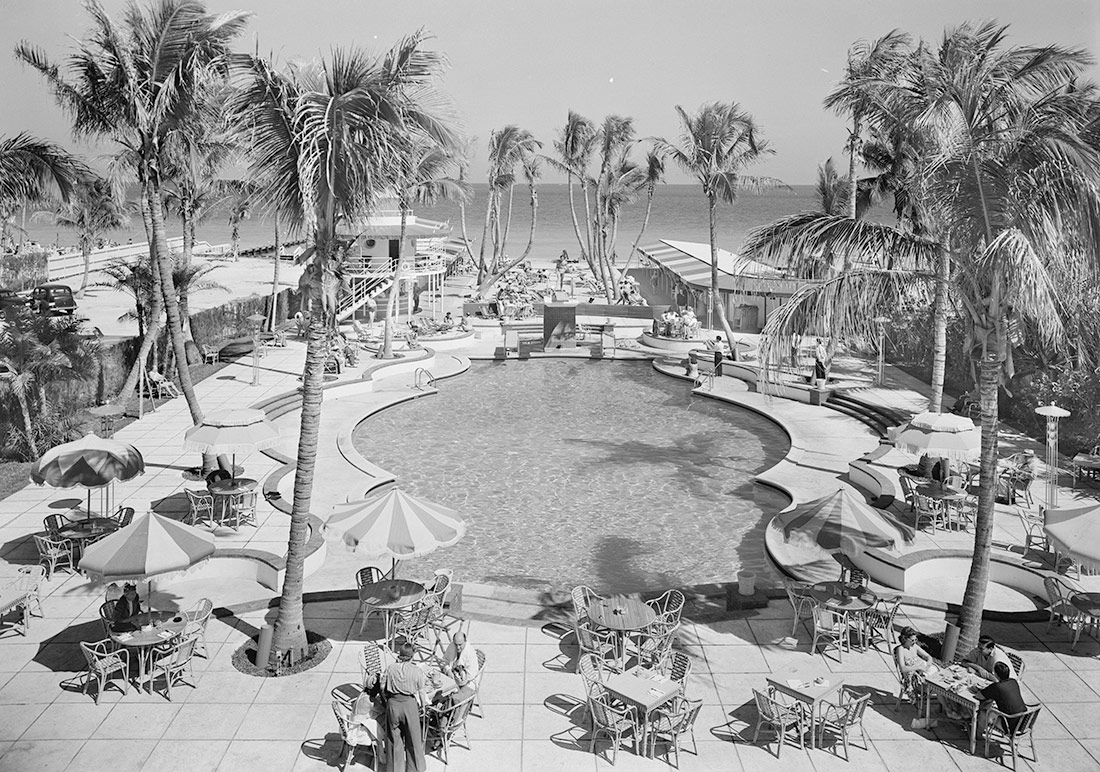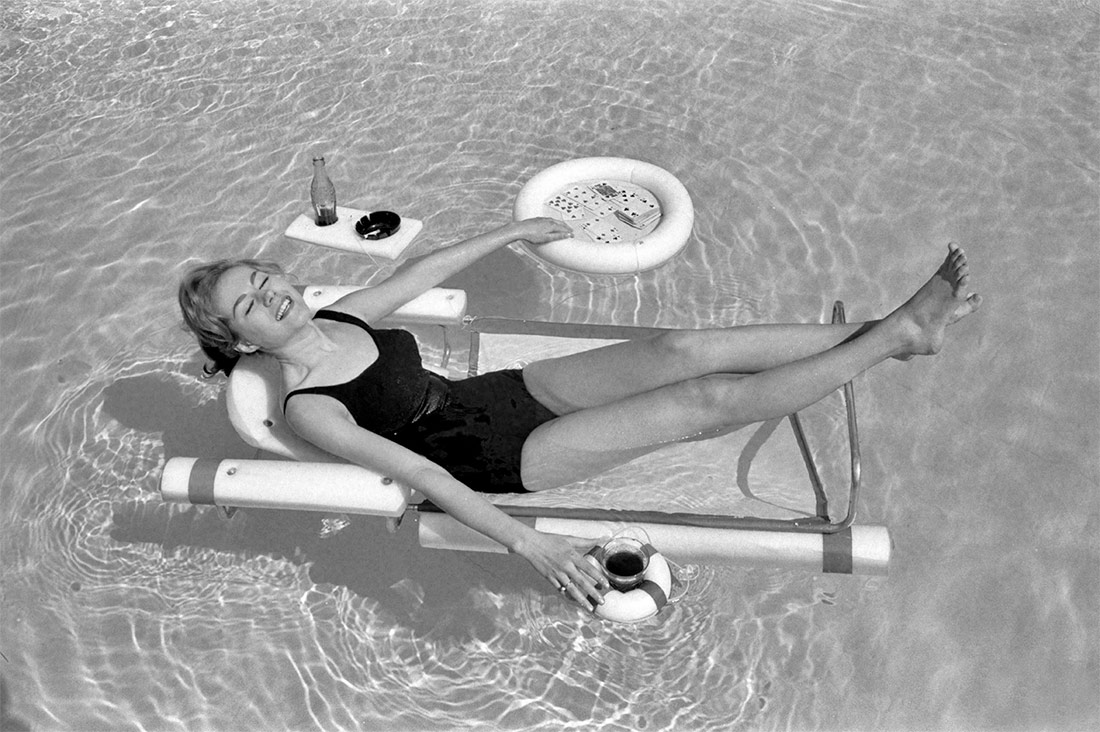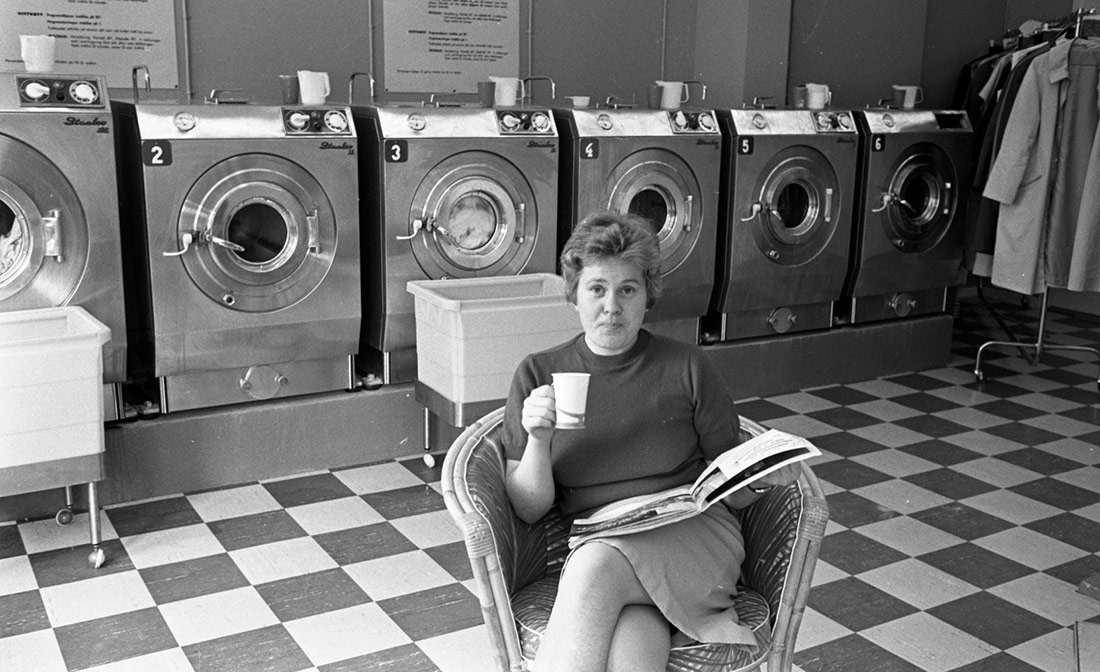
The Raleigh Hotel swimming pool, Miami Beach. Florida, 1941 | Gottscho-Schleisner, Inc., Library of Congress | Public domain
Their first incarnation was as love hotels, and they are now an important hotel segment based on an illusion. While the rites of adulthood have become blurred due to a change of paradigm, some people still need to believe that life after 20 consists of sun loungers and Aperol spritz, rather than paying council tax and making dentist appointments.
These are baroque times in the world of outdoor furniture. A sun lounger is no longer just a sun lounger. A sun lounger can also be a Bali bed measuring over two and a half metres wide, with room for four or five people with a low BMI. It can also be an ottoman with organic contours, sprawled out like a greedy caterpillar. There are S-shaped loungers formed of a single stroke, like a swoosh that invites you to rest rathet than run. There are loungers reminiscent of Polynesia or the Mayan Riviera, scrupulously minimalist, like the chairs of an Australian beach bar, or decadent, like the boudoir of an 18th-century French saloniste.
In my incursions onto hotel websites, a solitary vice like any other, I’ve seen things you wouldn’t believe. Sun loungers with built-in sunshades that look like those appetizer spoons that became fashionable at weddings in the noughties for slurping up 30 grams of prawn cocktail, reclining loungers that look like they emerge from the wood, as if a resourceful castaway had carved them out of a log using a multi-purpose machete. These ones are usually placed near water, so that your feet don’t stay dry for long.
And all these models of lounger, all these options for outdoor horizontality, can be found in the same place – in “adults-only” hotels. Or their close relative, the “adult-friendly” hotel. There is a more or less pre-set aesthetic code for these establishments, which is based on white surfaces – half Ibizan house, half private gyno clinic – although the segment has grown so much in recent years that “adults-only” now come in many prices and many styles, including the rustic chic style that favours lots of light wood. But whatever they look like, what is clear is that they will house at least two lounger options, and if it is an urban establishment and the loungers can only fit on the rooftop terrace, they will be crammed in somehow. The lounger is non-negotiable. The lounger is essential. Why on earth would anyone go to an adults-only establishment if not to say to themselves “I have lain on a lounger.”
Another integral part of the concept is the jacuzzi, or some kind of bathtub that can accommodate a couple. In fact, when you type “adults-only hotels” into Google, the main related search term is “adults-only hotels with jacuzzi in the room.” Some of the first establishments to include whirlpool tubs in the room were the so-called “love hotels” in the Pocono Mountains in Pennsylvania. Being relatively close to Boston, Philadelphia and other Eastern cities, the Poconos became fashionable as a honeymoon destination in the 1950s and 60s in the United States. To meet this demand, small love shacks sprang up, furnished according to the erotic fantasies of the time, somewhere between early Playboy and a number from an MGM musical – heart-shaped jacuzzis, round beds, bathtubs shaped like champagne glasses, a fireplace in the room and, for the more adventurous, ceiling mirrors and all-night room service that offered chocolate, sparkling wine and strawberries and cream.

Sunbathing with the latest swimming pool equipment, including a lounge chair with floating beverage holders and game table attachments.. 1961 | Bob Sandberg, Shorpy
The hotels in the Poconos, and those that began to appear in the 1970s in the Caribbean and Mexico’s Mayan Riviera, were not yet known as “adults-only” but as “couples-only”. The distinction has been blurred because there are hardly any hotels that define themselves as “couples-only” anymore, and because in practice adults-only hotels are mostly frequented by couples, both gay and straight. Hardly anyone ever thinks of booking them for a solo or group holiday because everything in adults-only establishments is designed to put into practice, for a few days, a very particular idea of adulthood, what the writer Jane Smiley brilliantly defined as “the age of grief,” one that might be envisaged by an eleven-year-old with a slightly feverish imagination rather than someone who is familiar with the concept of council tax.
There is an adults-only hotel in Tenerife that offers the possibility of having breakfast on a floating tray in the pool – which of course is an infinity pool. As it’s a Canarian-themed breakfast which includes banana pancakes, tomato and avocado tartar, and potato and sweet potato omelette with mojo, it doesn’t seem to require spreading butter on toast from an inflatable mattress, which is fortunate, because such an activity would involve a level of dexterity and hand-eye coordination that few adults can achieve. As a particularly clumsy person, the idea of pouring coffee and milk while floating in a pool makes my mind boggle.
Apart from the jacuzzi in the room, another very popular Google search is “what goes on at adults-only resorts?” and “are adults-only resorts clothing optional?” Again, it’s as if all these questions were being asked by an eleven-year-old. He detects a kinkiness, something steamy, but needs someone to clarify what exactly is going on at the side of these infinity pools. Even if there are doubts (“adults only meaning,” a good number of Google users also ask themselves, without beating around the bush) it is actually a triumph of branding that the industry has managed to transfer this vaguely risqué idea to its entire offering, which is essentially a very elaborate fantasy, like that resort in Greenland where Father Christmas is supposed to live.
On the surface, adults-only hotels offer their guests on a (floating) platter the possibility of not being surrounded by children for a few days. Neither their own, if they have them, nor anyone else’s. Meaning there are no small, dependent people around who demand Cornettos and wear arm bands and spoil the fantasy that has been so hard to build. Implicitly, they also promise a world without old people, although the only time in my life that I stayed in an establishment classed as adults-only (don’t ask) in the seaside town of Santa Susanna, the average age of the guests was over 70 and in front of the breakfast buffet there was a parking area with mobility scooters available to guests.

Laundry. Örebro, Suècia, 1965 | Örebro läns museum | Public domain
What they actually offer, at least the more sophisticated versions of these establishments – the villas with the immaculate lawns and the lush jungles overlooking the sea – is to confer, for a few days, a meaning to the word “adult” that is as far removed as possible from “adulting,” that somewhat irritating verb that changed its meaning in the middle of the last decade. In the 1980s, according to an etymological entry in the Merriam Webster, the verb “adulting” was (occasionally) used to refer to committing adultery. Then in the late 1990s, the English language, always flexible and open to neologisms, started to use it with the idea of “making more adult.” People talked, for example, of adulting cinemas with wide armchairs and food options. In 2013, the journalist Kelly Williams Brown published a compilation of entries from her blog entitled Adulting: How to Become a Grown-up in 468 Easy(ish) Steps (the book based on a blog is another important relic of that era) in which the word was used with its current meaning of “to behave like an adult, to do the things that adults regularly have to do. This includes things like having a job and living independently, sure, but also such mundanities as taking clothes to the dry cleaners (and remembering to pick them up), making and keeping dental appointments, getting your car registered, doing yardwork,” in the words of the Merriam Webster.
Note that the definition includes the words “job,” “dry cleaners,” “dental appointments,” “car” and even “yard”. The fantasy of ownership that the dictionary portrays here resembles those memes in which people compare what they do at 25 or 30 with what their parents did, and in which the parents always magically have several houses and vehicles to their name.
The book by Kelly Williams Brown that defined the idea of “adulting” for millennials, then still used in the media as a synonym for “young people,” was a mixture of practical advice such as “have the tires looked at before the car breaks down” (again, what car?) or “clean your fridge shelves every month” and others on social interaction, such as “don’t treat your friends like free therapists” or “learn to chat with your neighbours”. The Cut interviewed the author a few months ago on the tenth anniversary of the publication of the book, which was remarkably successful and became, according to the article, an essential part of the “Obama-era zeitgeist,” when the media began to talk about how young people were on the hook for everything the boomers had squandered. Writing a book about being an adult allowed the author to enter adulthood in style – with a contract with J.J. Abrams’ production company to turn her book into a series, speaking tours and the kind of media glitz afforded to authors of a popular bestseller. In 2017 she published an expanded edition with even more steps to follow to be an adult – 536 no less.
Applying them, or trying to, did not save Kelly Williams Brown from the inevitable. As she herself has admitted, she suffered “a catastrophic breakdown of the self.” To sum it up, she says, “Divorce, Trump election, I broke my elbow and fractured my shoulder, my dad got cancer, my grandma died, my cat died, I fell into a deep depression. I quietly quit my job as the adulting girl.” On top of it all, the very premise she had sold, that by following these 500 or so steps you could move towards a stable and happy life, seemed to be failing. “When bad things happened, which they did, it became something more – if I ask for help and tell people I’m not okay, am I undermining the central point of my whole career?” she asks.
The parable is so obvious that it almost seems crude – while trying to define what adulthood was, adulthood happened to her. And it was far worse than expected. Williams Brown says that if she were to write the book now, she would include a chapter on how, in the age of grief, “you keep moving forward when you so deeply don’t feel like you can,” which is a definition of “adulting” that is more depressing but also more fitting than wearing a clean shirt to a job interview and not leaving the tax return to the last week, though also less splendid than breakfast in an infinity pool.



Leave a comment